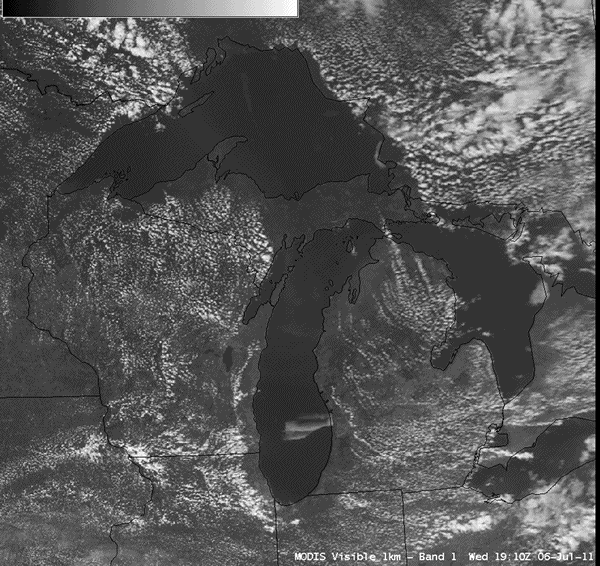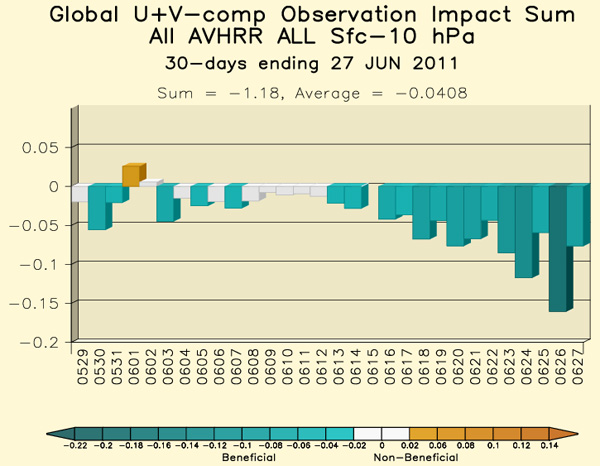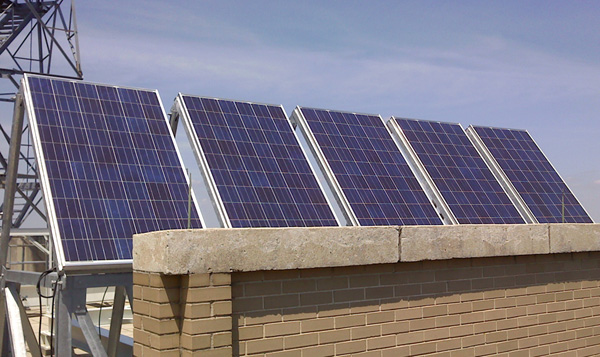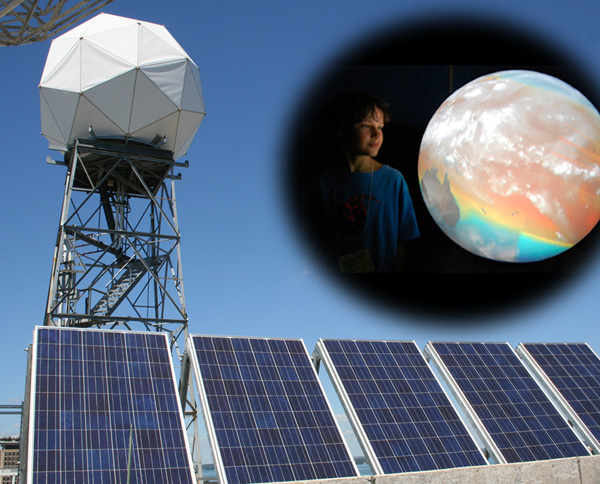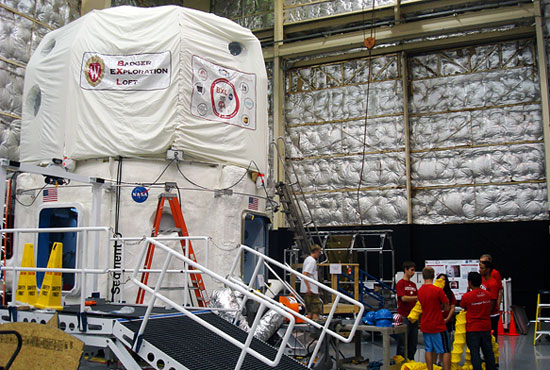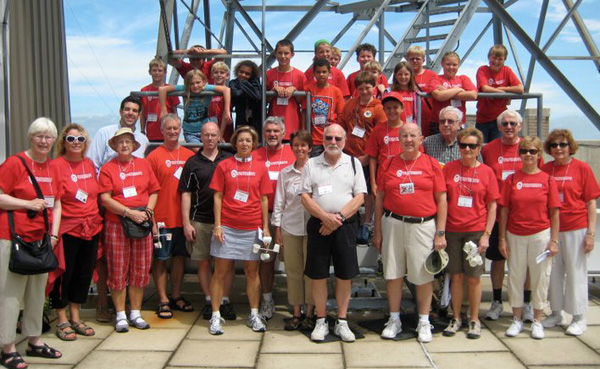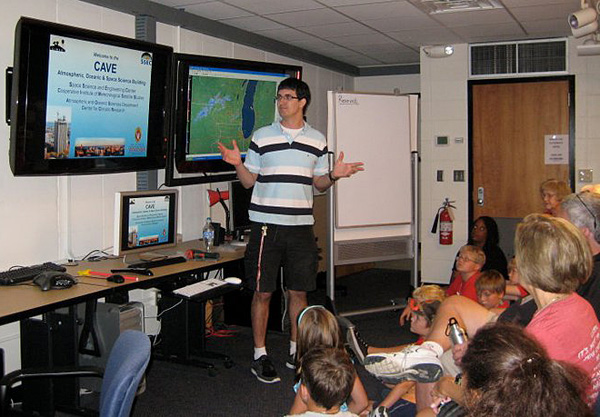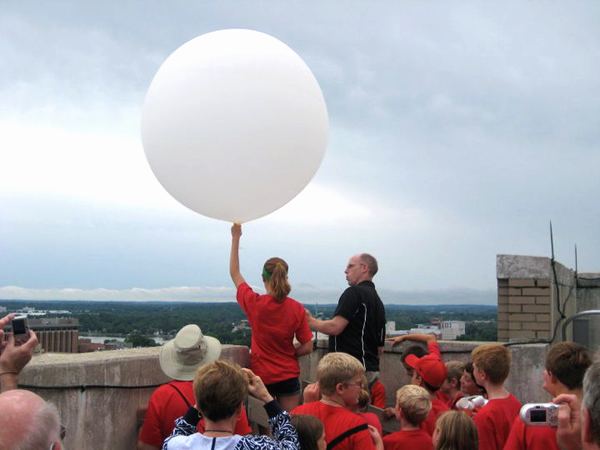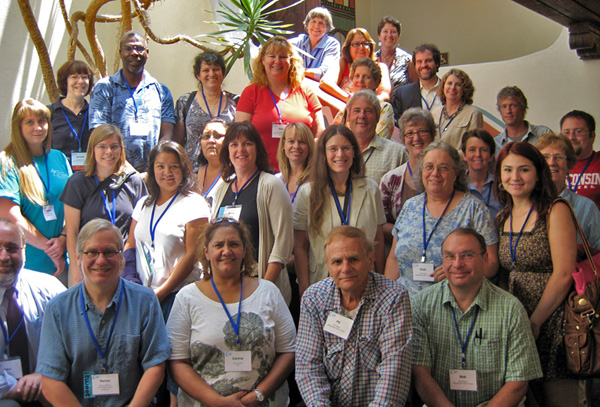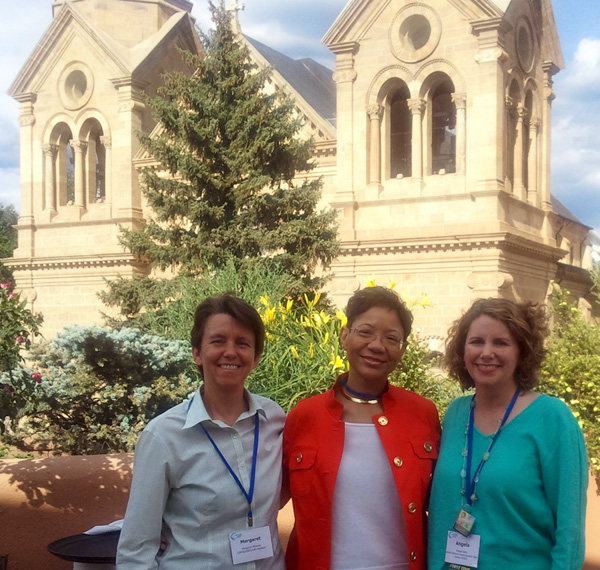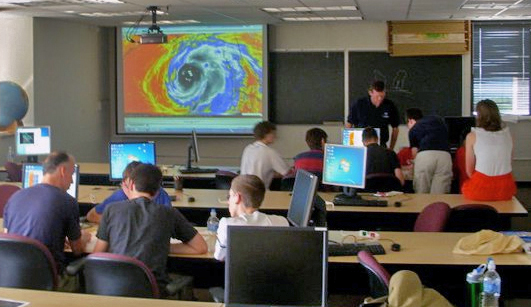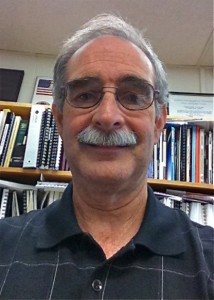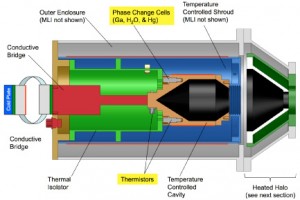Monthly News Summary – August 2011
- Major Milestone – Five Years of Research to NWS Operations
- Update to AVHRR Polar Winds Processing at CIMSS
- GOES-derived Products Demonstrated at NWS Sullivan
- Solar Panels Complete AOSS Sun-Earth Exhibit
- BAMS Highlights Weather Quest
- UW-Madison Team Wins NASA eXploration Habitat Academic Innovation Challenge
- Grandparents University Comes to AOSS
- Teacher Workshop on Climate Literacy and Earth Data Tools
- Presentation at AMS Annual Teachers Training Meeting
- 19th Annual CIMSS High School Workshop held in Madison
- Training Sessions on GOES-R Fog and Cloud Type Products
- Fred Best Attains Distinguished Level
Major Milestone – Five Years of Research to NWS Operations
On 07 July 2011, the Cooperative Institute for Meteorological Satellite Studies (CIMSS) reached a major milestone: five years of a successful research-to-operations exercise with National Weather Service (NWS) field offices across the country.
CIMSS started providing MODerate resolution Imaging Spectroradiometer (MODIS) imagery displayable in the Advanced Weather Interactive Processing System (AWIPS) to the NWS Weather Forecast Office (WFO) forecast office near Milwaukee, Wisconsin, on 07 July 2006.
This sample of the type of MODIS products supplied illustrates that on 06 July 2011 generally cloud-free conditions over the western Great Lakes allowed a nice view of the Sea Surface Temperature (SST) across that region. Note that SST values were still as cold as 40.3º F over parts of Lake Superior. The corresponding MODIS 0.65 µm visible image showed a few well-defined lake breeze boundaries, as well as a thin northwest-to-southeast oriented plume of smoke from wildfires burning in Canada.
Since then, the real-time distribution of CIMSS and STAR Advanced Satellite Products Branch (ASPB) experimental satellite imagery and products has grown to 70 NWS WFOs, Headquarters, and Centers nationwide. The imagery and products, based on unique Area Forecast Discussion (AFD) references, have contributed to more than 440 forecast decisions.
This activity has been furthered in recent years as a result of the Geostationary Operational Environmental Satellite R-Series (GOES-R) Proving Ground program, which closely pairs the research and operational communities to demonstrate the capabilities of our nation’s next-generation geostationary satellites.
CIMSS has distributed model output from the CIMSS Regional Assimilation System (CRAS), imagery and products from polar-orbiting instruments, such as the Advanced Very High Resolution Radiometer (AVHRR), and simulated imagery from the Weather Research and Forecast (WRF) model. It continues this activity under a proving ground readiness exercise for the Geostationary Operational Environmental Satellite R-Series (GOES-R).
Update to AVHRR Polar Winds Processing at CIMSS
A significant update to the Advanced Very High Resolution Radiometer (AVHRR) polar winds processing at CIMSS was introduced on 16 June 2011.
An increase in the spatial coverage over the poles, more accurate time tagging of images, and the production of winds across the day boundary has resulted in many more winds and an improved impact in the Naval Research Lab’s (NRL) Atmospheric Variational Data Assimilation System – Accelerated Representer (NAVDAS-AR).
The AVHRR winds are generated routinely at CIMSS using the Global Area Coverage (GAC) data from all operating NOAA polar orbiting satellites and the Full Resolution Area Coverage (FRAC) from Metop.
Improved model performance resulting from an update of the AVHRR polar wind processing can be seen by comparing the observational impact in the latter half of June 2011, after the update was made, to the first half of the month. (Provided by Nancy Baker, NRL, and Randy Pauley, Fleet Numerical Meteorology and Oceanography Center)
GOES-derived Products Demonstrated at NWS Sullivan
On 05 July 2011, Robert Aune and Jordan Gerth (CIMSS) spent the day at the National Weather Service Office, Sullivan, WI (MKX) as part of the GOES-R Local Area Testbed being conducted by CIMSS. While there, they trained forecasters on the use of GOES fog detection products and GOES Sounder near-casting products.
On this day the near-casting products were found useful for estimating locations where convective storms were most likely to form in Central Wisconsin. The strongest storms tended to form along horizontal gradients of instability that were near-casted 3 to 5 hours in advance by the GOES Sounder Near-casting model.
Solar Panels Complete AOSS Sun-Earth Exhibit
In 2008 when Rick Kohrs and Margaret Mooney applied to the Baldwin Endowment fund to acquire the first Wisconsin-based 3-D weather globe, they simultaneously asked Madison Gas and Electric (MG&E) to support the acquisition of solar panels that could power the spherical display system.
Mooney and Kohrs envisioned an exhibit that models the Sun-Earth system with energy from the solar panels powering 3-D displays of Earth animations. MG&E sent a check within weeks! The SSEC weather globe was installed on the first floor in 2009. However, getting the solar panels installed on the roof took a while longer.
Considerations included a southward exposure on stands sturdy enough to withstand high winds while propping the panels above the roof wall without taking up too much space. Don Thielman worked with MG&E and H&H Electric to iron out the initial details. Hanging the solar panels off the side of the building was contemplated but the University wouldn’t approve this configuration.
In 2010 Mark Werner took up the torch and saw the project through to completion. The frames were designed by Edge Consulting Engineers of Prairie du Sac, WI, and built
by the UW Physical Sciences Lab. The solar panels were finally installed in June 2011!
Along with modeling the essential Sun-Earth connection, this exhibit provides an excellent opportunity to teach about renewable energy, the electromagnetic spectrum and remote sensing topics. The exhibit further paves the way for instructional programs around global and regional climate change. And while the size of the solar array (1kW PV) was calculated based on the electricity needed to power the 3-D globe (6 days a week for 10 hours a day), the electricity from the panels goes directly into the Atmospheric, Oceanic and Space Science Building, meaning that any extra electricity generated will have the added benefit of reducing our collective carbon footprint.
Steve Ackerman, Jean Phillips, and Matt Sitkowski, SSEC/CIMSS members of the Weather Quest planning team, contributed to the great success of the first Weather Quest, a game-based exercise conducted at the 2011 AMS Student Conference in Seattle.
Weather Quest was celebrated (pdf file) in the May issue of the Bulletin of the American Meteorological Society (BAMS). The goal of the Quest was “to encourage young scientists to network with each other, take full advantage of the conference program, and encourage future conference attendance and participation in the AMS.” About 500 students attend the AMS Student Conference each year.
Student conference planners were enthusiastic about repeating Weather Quest next year because it “energized the students, made them think, and most importantly, through the ice-breaker activity during the luncheon, necessitated that they meet each other and share information about themselves and their educational goals, while at the same time, solving problems.”
UW-Madison Team Wins NASA eXploration Habitat Academic Innovation Challenge
An interdisciplinary team of University of Wisconsin-Madison undergraduate students won the NASA eXploration Habitat Academic Innovation Challenge (X-Hab) with their innovative “Badger Exploration Loft (X-Loft). The competition charges university teams to design and rapidly develop inflatable, habitable spaces that NASA can integrate onto an existing demonstration laboratory.
Several UW-Madison units, including the departments of Mechanical Engineering and Engineering Physics, the School of Human Ecology, Wisconsin Space Grant Consortium, and the Space Science and Engineering Center (SSEC), as well as local and regional companies, provided financial and in-kind support for the project.
The Badger X-Loft prototype, designed by an interdisciplinary team of students studying engineering mechanics, mechanical engineering, textile and apparel design, and finance and economics, has won the NASA eXploration Habitat Academic Innovation Challenge.(
Photo: courtesy Nicole Roth)
Fred Best, one of SSEC’s Executive Directors, worked on the project in an advisory capacity and said of the student team: “What so impressed me about the team was that it really was a “team” in the truest sense of the word. When something needed to get done people stepped up, nobody passed the buck. When that happens consistently, by everyone on the team, it seems impossible things can get done. I also observed and appreciated the professionalism of the team. To a person everyone I worked with was courteous, on-time, prepared, eager to learn, and ready to dig out any information that wasn’t readily available.”
The UW-Madison team deployed and displayed its prototype at the NASA Johnson Space Center, Houston, on 20-24 June 2011. For its win, the team receives an additional $10,000 and several members will spend September in Arizona, where they will test their habitat as part of a simulated astronaut mission to an asteroid in the annual NASA Desert Research and Technology Studies (Desert-RATS) field test.
The Badger X-Loft prototype is approximately 13 feet tall and 16 feet in diameter. Perched atop the NASA habitat demonstration unit laboratory, the habitat can house four crew members for several days and includes a desk and chair for each person, several windows styled like a ship’s portholes, and a second story “loft” with private sleeping quarters.
A time-lapse video shows the team setting up its habitat in the Engineering Centers Building on the UW-Madison campus. A UW Communications article about the UW-Madison team and its victory is available online.
Grandparents University Comes to AOSS
For the 6th consecutive summer, UW Alums and their grandchildren enrolled in the meteorology major at the Atmospheric, Oceanic and Space Science Building for Grandparents University. Patrick Rowley, Jean Phillips, Jordan Gerth, Erik Olson and Margaret Mooney led activities in the AOSS 14th floor computer lab, the CAVE (CIMSS Analysis and Visualization Environment), the 3D globe room and the roof.
Enthusiast feedback followed each session but the clear favorite was the exciting weather balloon launch facilitated by SSEC researcher Erik Olson. On Wisconsin!
Teacher Workshop on Climate Literacy and Earth Data Tools
With support from NOAA, the Cooperative Institute for Meteorological Satellite Studies (CIMSS) organized a teacher workshop at the Federation of Earth Science Information Partners (ESIP) summer meeting in Santa Fe 12-13 July 2011. The workshop had an overall theme of Earth science education with an integral strand dedicated to climate literacy.
Along with sessions on climate change science, climate resources, and ways to effectively communicate climate change, educators could choose from several breakout sessions demonstrating ways that Earth science data can be used in science classrooms.
Margaret Mooney (CIMSS/SSEC), Patricia Huff (NOAA NESDIS), and Angela Sallis (NOAA NODC).
The breakout sessions were led by ESIP members from NOAA, NASA, EPA and several Universities from around the country. CIMSS presenters included Margaret Mooney and Tommy Jasmin.
Presentation at AMS Annual Teachers Training Meeting
Tom Whittaker (CIMSS) presented the newly completed, on-line, interactive Conceptual Energy Model (CEM) tool on 27 June 2011 at the annual K-12 American Meteorological Society (AMS) Teacher’s Training, held this year in Green Bay, Wisconsin.
The original process (algorithm) for the CEM was developed by the AMS Education group in the 1990’s, but had never been realized as a computer program previously. All computations were done manually, thus limiting the opportunity to more extensively explore the Model. The AMS fully supported this development.
19th Annual CIMSS High School Workshop held in Madison
Ten high school students from as far away as Connecticut participated in the 2011 CIMSS High School Workshop on Atmospheric, Earth, and Space Sciences, held 26-30 June 2011 on the University of Wisconsin-Madison (UW) campus.
The workshop included field trips to WKOW-TV 27, Weather Central, LP, the National Weather Service (NWS) forecast office in Sullivan, WI, the UW Geology Museum, Washburn Observatory, the UW Planetarium, the “Satellites See Wisconsin” exhibit at the Madison airport, Devil’s Lake State Park and the surrounding area for a tour of geologic features, and Madison’s Lake Mendota for a limnology dredging expedition.
CIMSS scientists Matt Sitkowski and Derrick Herndon work with students during the hurricane forecasting session of the CIMSS High School Workshop, on 28 June 2011.
Numerous presentations were given at the Space Science and Engineering Center (SSEC) including Earth System Science, the 3D Globe, daily weather briefings, basic and satellite meteorology, tropical weather and forecasting (a crowd favorite), GIS (geographical information system) and remote sensing, weather at Antarctica, climate change, and aviation weather.
Mentor-guided training and student demonstrations were done in the traditional half day session with the SSEC Man-computer Interactive Data Access System (McIDAS).
Training Sessions on GOES-R Fog and Cloud Type Products
Michael Pavolonis (NOAA/NESDIS) and Corey Calvert (CIMSS) hosted two teletraining sessions (07 and 21 July 2011) with the National Weather Service (NWS) Alaska Region on the next generation Geostationary Operational Environmental Satellite (GOES-R) fog and cloud type products developed by the GOES-R Algorithm Working Group (AWG).
In total, 31 people from the NWS Alaska Region participated. The GOES-R AWG fog and cloud type products are being provided to the NWS Alaska Region via the GOES-R Proving Ground.
In addition, on 19 July 2011, Pavolonis and Calvert spent the day at the NWS Weather Forecast Office (WFO) in Sullivan, WI, as part of the GOES-R Local Area Testbed being conducted by CIMSS. While there, they trained a forecaster on the use of the GOES-R fog and cloud type products, both of which were positively received.
Fred Best Attains Distinguished Level
Fred Best, SSEC’s Executive Director for Technology, has been advanced to the academic staff “Distinguished” level, an honor reserved for a small number of academic staff whose superlative accomplishments are evidenced by widespread peer recognition. Only 36 academic staff members at the University of Wisconsin-Madison have been awarded this status.
A Distinguished academic staff member is expected to develop new approaches, methods or techniques to resolve or prevent problems with little or no expert guidance and to cope independently with new, unexpected or complex situations. Neither seniority nor longevity is sufficient for award of this designation.
Best’s work in developing phase change cells used for determining extremely accurate on-orbit temperature calibration was the chief reason for his nomination. The twelve-member committee (comprised of twelve Distinguished level academic staff members) approved the honor unanimously.
Congratulations, Fred!

